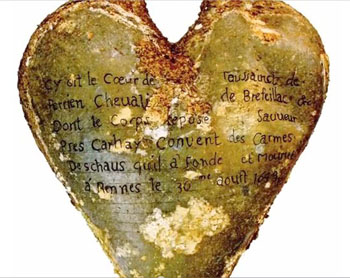Modern Medical Imaging Techniques Reveal Evidence of Heart Disease in Ancient Hearts
By MedImaging International staff writers
Posted on 15 Dec 2015
Researchers are presenting an analysis of preserved hearts from an archeological site dating to the late 16th to early 17th century, at the annual meeting of the Radiological Society of North America (RSNA 2015).Posted on 15 Dec 2015
The hearts were analyzed using modern Magnetic Resonance Imaging (MRI) and Computed Tomography (CT) scanning techniques. Researchers were able to identify heart chambers, valves, and coronary arteries, and found plaque and atherosclerosis on three of the preserved hearts. The discovery has led researchers to believe that these diseases also existed more than 400 years ago.

Image: Heart-shaped lead urn with an inscription identifying the contents as the heart of Toussaint Perrien, Knight of Brefeillac (Photo courtesy of RSNA).
The grave sites were excavated by archaeologists from the French National Institute for Preventive Archaeological Research (INRAP; Paris, France) in the basement of the Convent of the Jacobins in Rennes, France. The hearts belonged to members of upper-class families and were found in five heart-shaped lead urns. Forensic radiologists and physicians, archeologists, pathologic physicians, and physicists from the Molecular Anthropology and Synthesis Imaging and the Institute of Metabolic and Cardiovascular Diseases took part in the study.
The MRI and CT scans themselves did not reveal much health information due to the embalming materials used to preserve the hearts. To improve the imaging results the researchers carefully removed the embalming material, rescanned the hearts, and were able to discern heart chambers, valves and coronary arteries. The researchers then rehydrated the hearts and used MRI scans to identify myocardial muscles. The researchers also used standard pathological examination methods of the heart tissues including dissections, histology, and external studies.
Study author, Fatima-Zohra Mokrane, MD, radiologist, Rangueil Hospital, University Hospital of (Toulouse, France), said, "We tried to see if we could get health information from the hearts in their embalmed state, but the embalming material made it difficult. We needed to take necessary precautions to conduct the research carefully in order to get all possible information. Since four of the five hearts were very well preserved, we were able to see signs of present-day heart conditions, such as plaque and atherosclerosis. It was common during that time period to be buried with the heart of a husband or wife. This was the case with one of our hearts. It's a very romantic aspect to the burials."
Related Links:
INRAP
Rangueil Hospital














